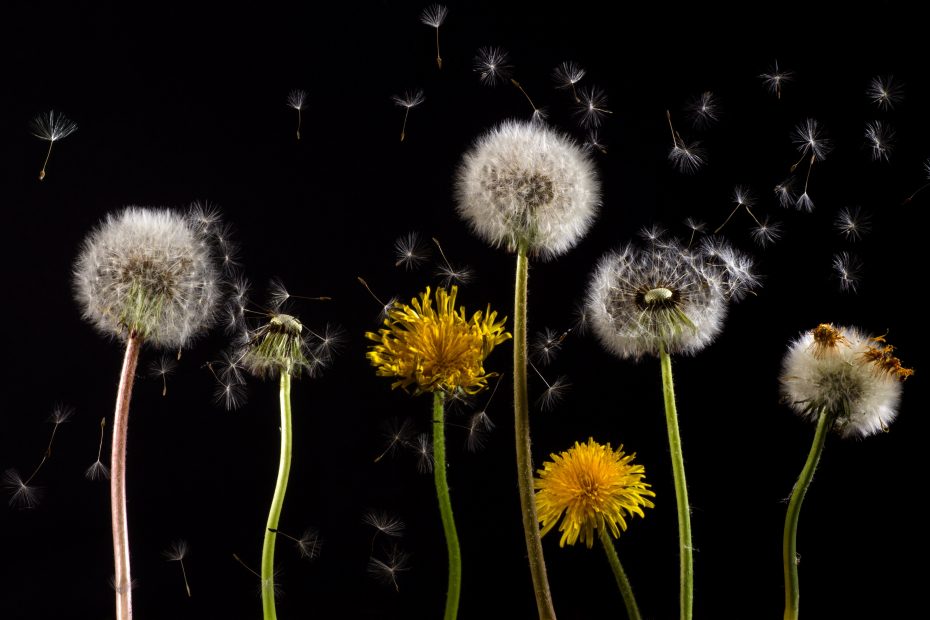What is dandelion herbal tea?
Are you familiar with dandelion tea? Surely yes, but you may not have realized it yet… when spring is late and we are approaching the first heat of summer, even in the city it is common to find yourself sweeping up the so-called “dandelions.” Well, they are none other than the fruits of the dandelion.
The species Taraxacum officinale belongs to the Asteraceae family and is considered a weed, like mint. The plant has a stout root from which large green leaves sprout.
The inflorescence is the well-known dandelion, a bright yellow flower with a long, smooth stem. The fruit is called the dandelion and consists of seeds provided with pappus, which is a feathery, light appendage that helps the seeds to be dispersed by the wind.
Dandelion herbal tea: how to prepare it
To prepare dandelion herbal tea you can use the roots (fresh or dried), flowers or leaves. Depending on the raw material then it is best to go for a decoction or an infusion. Why? I explain it here
Dandelion decoction
- 30 to 40 g of fresh dandelion roots (or 6 teaspoons of dried root)
- 1 liter of natural mineral water
To prepare a decoction, bring the water and roots to a boil in a large saucepan.
Let it simmer for about 10 minutes then turn off the heat and let it rest. I have noticed that the resting time changes depending on the effects you want to achieve. Same for when and how often to drink the decoction. Ask your doctor (especially for drug interactions) or trusted naturopath for advice.
Finally, strain.
Dandelion infusion
- 3 g of dried dandelion leaves and/or flowers per cup (if fresh, calculate half a cup of raw material)
- one cup of natural mineral water
- brown sugar (to taste)
To prepare an infusion, wash the leaves and/or flowers well if they are fresh. Arrange them in a strainer inside a cup or teapot.
Bring a cup of water almost to a boil (about 95° C).
Pour the water over the filter or over fresh flowers and/or leaves and let it steep for 5 minutes.
Strain and sweeten to taste.
Fresh leaves are also widely used in cooking in salads or omelets.
Dandelion: properties
This is a wild plant that blooms and ripens just in spring, after the big Easter binge, amid the stress of the change of season and the dread of the swimsuit test.
What are its properties? First, remember that it continene mineral salts (calcium, iron, sodium, phosphorus, magnesium, potassium, selenium and zinc) and vitamins (A, B1, B2, B3, C, E, K). There is no shortage of tannins, flavonoids, caffeic acid, coumaric acid and mucilage.
Dandelion is indicated in cases of water retention and cellulite, lack of good digestion, liver and biliary insufficiency. The benefit on the digestive system is due to the presence of bitter substances such as inulin and taraxicin. These, in fact, facilitate digestion by stimulating the production of saliva, gastric and pancreatic juices and bile. These substances also help bacterial flora and intestinal transit. They say that drinking a decoction twice a day for a week helps regulate bowel function. For digestive benefits, it seems that infusion of the flowers is particularly effective.
The diuretic properties of dandelion should not be overlooked: flavonoids and potassium salts facilitate the elimination of excess fluids and toxins. After all, it is often mentioned when talking about purification. And to confirm the diuretic and detox properties, the Italian language comes to our aid: common name for dandelion is also piscialetto! For a better diuretic effect they recommend infusion of dandelion leaves.
These purifying properties lead to another result: the control of cholesterol levels. In this case, dandelion root decoction is recommended.
Dandelion: contraindications
This plant is full of interesting benefits. However, one must be careful about contraindications. In fact, it can create problems for those suffering from gastritis, gastroesophageal reflux, peptic ulcer, and biliary tract obstruction.
Also watch out for interactions with some medications: painkillers, diuretics and hypoglycemic drugs. Specifically, contraindications include nonsteroidal anti-inflammatory drugs (NSAIDs), such as aspirin, because dandelion may accentuate the harmful action on the gastric wall.
Dandelion honey: what is it?
From the dandelion we obtain a superior honey, which encapsulates in sweet notes all the properties of the flower. Indeed, it is distinguished from other honeys by its bright yellow color and full-bodied, penetrating odor.
Dandelion blossoms from February to the first half of May, so the bloom used is early. It is in fact quite difficult to obtain honey from these flowers. Partly because the weather conditions are not always favorable, partly because the bees are still fatigued from the winter and sometimes the families are not yet developed enough to cope with honey harvesting.
Recipe for false dandelion honey
There is, however, fake dandelion honey, a product similar to that produced by bees with properties on the gut, liver and respiratory tract. In addition, it is vegan.
- 700 g dandelion flowers
- 3 lemons
- 7 dl water
- 700 g sugar
To prepare false dandelion honey, wash the flowers well.
Place them in a saucepan with the water and lemons cut into chunks and bring to a boil. Let simmer for 5 minutes. Turn off the flame and let cool.
Separate the flowers and squeeze them in a potato masher or vegetable masher.
In the collected liquid, dissolve the sugar, put it on the heat and simmer until it reaches a thick, honey-like syrup.
